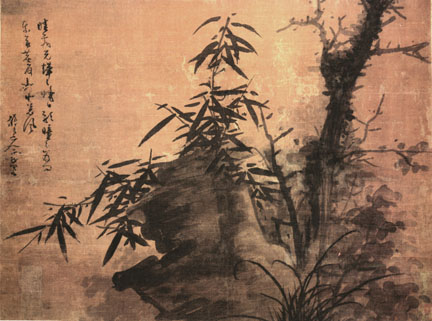

| Amateur painters, from Su Shi and
his friends on, had favored painting bamboo and flowering plum in ink
monochrome, in part at least because those skilled in the use of the
brush for calligraphy could master these genres relatively easily.
Bamboo, plum, orchid, pine, and other plants had over the centuries
acquired a rich range of associated meanings, largely from poetry.
In Song and especially Yuan times, scholar painters began to
systematically exploit these possibilities for conveying meaning through
their pictures.
Orchids, ever since Qu Yuan in the Warring States Period, had been associated with the virtues of the high-principled man. The orchid is fragile, modest, but its fragrance penetrates into hidden places. |
||||
|
Note that there is no ground in this painting. When asked why he omitted it, Zheng said that the barbarians had stolen the ground. |
||||
Zheng Sixiao (1241-1318), Orchid
|
||||
 The
artist here has inscribed a poem on the painting that refers to the
coolness and refreshing quality of the autumn melon for one who is
experiencing the full heat of summer. The
artist here has inscribed a poem on the painting that refers to the
coolness and refreshing quality of the autumn melon for one who is
experiencing the full heat of summer.
Because of this poem, well-educated viewers of this painting would think of literary references to melons, giving the painting deeper meaning. Just from looking at this painting, would you have guessed that it carried any larger meaning?
|
||||
Qian Xuan (ca. 1235- after 1301), Autumn Melon
|
||||
|
Bamboo, because it is flexible and can withstand storms without breaking, is a symbol of survival in adversity.
|
||||
Zhao Mengjian (1199? - 1264 AD), Three Friends of Winter
For a closer view, click here. [In the guide, below] |
||||
|
What do you think pine and plum symbolize?
|
||||
|
||||
| Note the inscriptions on the
painting below, added by scholars who viewed it.
Do you think the artist left space for the inscriptions? |
||||
|
|
||||
Wu Zhen (1280-1354), Plum and Bamboo
|
||||
|
||||

Wu Zhen, the painter of this rock and bamboo, was a true recluse, who rarely left his hometown and made his living by practicing fortune-telling and selling paintings. |
||||
Wu Zhen (1280-1354), Old Tree, Bamboo and Rock
|
||||
 Although
bamboo leaves could be painted with single, calligraphic strokes, of the
sort Wu Zhen used above, some literati painters also did bamboo with
outline and fill techniques associated more with professional and court
painters. Although
bamboo leaves could be painted with single, calligraphic strokes, of the
sort Wu Zhen used above, some literati painters also did bamboo with
outline and fill techniques associated more with professional and court
painters.
Do you think the way the bamboo was painted affected the way people interpreted its meaning? Compare this bamboo painting to the ones above and below in terms of brushwork and composition.
|
||||
Li Kan (1254-1320), Bamboo and Rock
|
||||
|
|
||||
Tan Zhirui (Yuan), Bamboo and Rocks
|
||||
|
Why would scholar painters paint brightly colored flowers like peonies in different tones of ink? |
||||
Wang Qian (Yuan), Peony
|
||||
| One of the qualities sought by scholar painters was simplicity, plainness, understatement, seen as the opposite of showy, flashy paintings. Paintings of plums often were done using very simple strokes. | ||||
|
This is just a small detail of a painting of a blossoming branch by Wang Mian. To see the entire painting, click here.
|
||||
Wang Mian (1287-1359), Ink Plum
|
||||
|
||||
|
Would you have been able to tell that this painting was done by several different hands? What would artists have gotten out of collaborating to make a single painting? |
||||
|
||||
|
Move on to Technical Aspects of Painting |